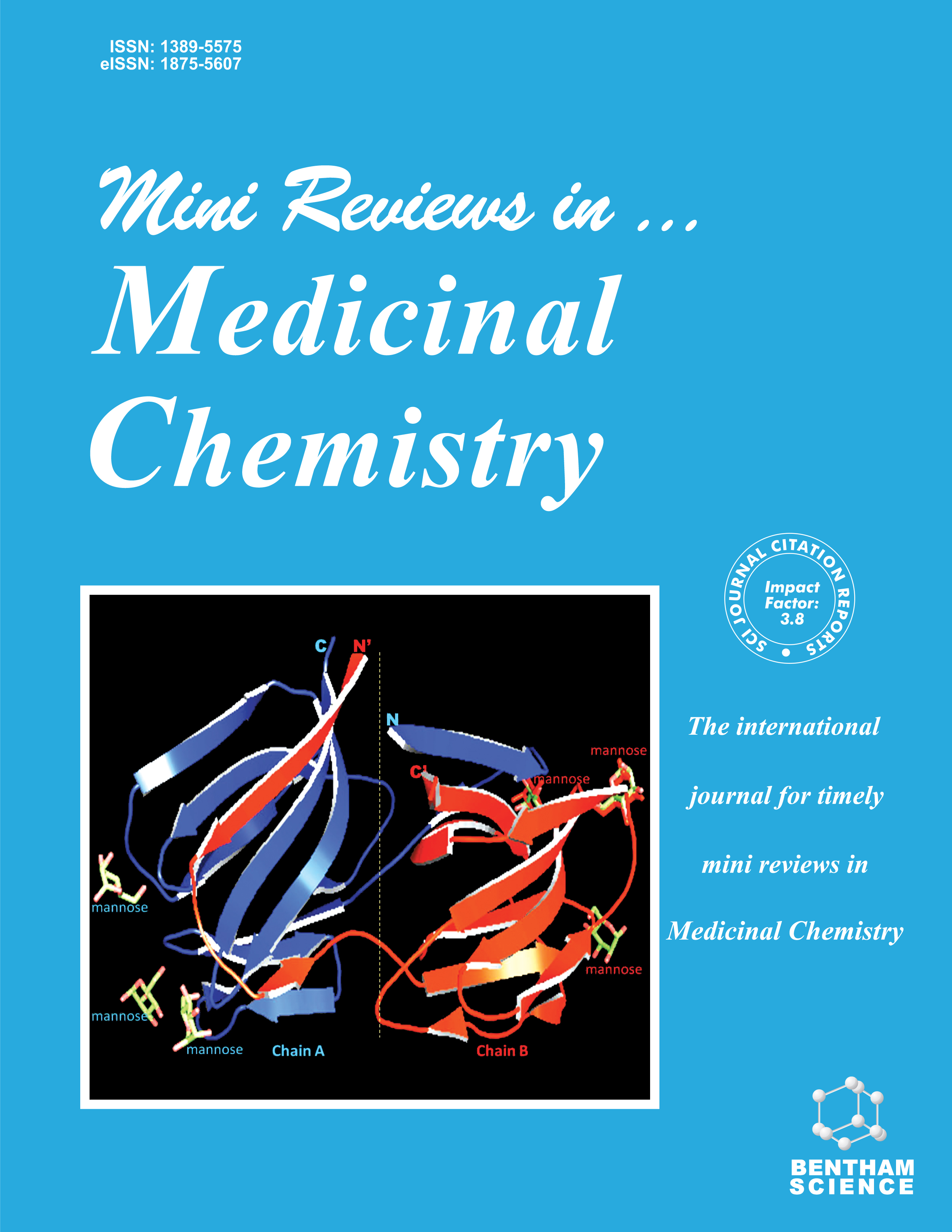- Home
- A-Z Publications
- Mini Reviews in Medicinal Chemistry
- Previous Issues
- Volume 21, Issue 7, 2021
Mini Reviews in Medicinal Chemistry - Volume 21, Issue 7, 2021
Volume 21, Issue 7, 2021
-
-
Dual Modulators of p53 and Cyclin D in ER Alpha Signaling by Albumin Nanovectors Bearing Zinc Chaperones for ER-positive Breast Cancer Therapy
More LessAuthors: Shyam S. P, Podila Naresh, Justin A, Ashish Wadhwani, Suresh Kumar M and Selvaraj JubieThe inherited mutations and underexpression of BRCA1 in sporadic breast cancers resulting in the loss or functional inactivation of BRCA1 may contribute to a high risk of breast cancer. Recent researchers have identified small molecules (BRCA1 mimetics) that fit into a BRCA1 binding pocket within Estrogen Receptor alpha (ERα), mimic the ability of BRCA1 to inhibit ERα activity, and overcome antiestrogen resistance. Studies i Read More
-
-
-
The Involvement of the Mammalian Target of Rapamycin, Protein Tyrosine Phosphatase 1b and Dipeptidase 4 Signaling Pathways in Cancer and Diabetes: A Narrative Review
More LessAuthors: Jiajia Zhang, Ning Wu and Dayong ShiBackground: The mammalian target of rapamycin (mTOR), protein tyrosine phosphatase 1b (PTP1B) and dipeptidase 4 (DPP4) signaling pathways regulate eukaryotic cell proliferation and metabolism. Previous researches described different transduction mechanisms in the progression of cancer and diabetes. Methodology: We reviewed recent advances in the signal transduction pathways of mTOR, PTP1B and DPP4 regula Read More
-
-
-
Novel Mitochondria-targeted Drugs for Cancer Therapy
More LessThe search for mitochondria-targeted drugs has dramatically risen over the last decade. Mitochondria are essential organelles serving not only as a powerhouse of the cell but also as a key player in cell proliferation and cell death. Their central role in the energetic metabolism, calcium homeostasis and apoptosis makes them an intriguing field of interest for cancer pharmacology. In cancer cells, many mitochondrial sign Read More
-
-
-
S-adenosyl-L-homocysteine Hydrolase: Its Inhibitory Activity Against Plasmodium falciparum and Development of Malaria Drugs
More LessAuthors: Girish Chandra, Samridhi Patel, Manoj Panchal and Durg V. SinghParasite Plasmodium falciparum is continuously giving a challenge to human beings by changing itself against most of the antimalarial drugs and its consequences can be seen in the form of a huge number of deaths each year especially in the poor and developing country. Due to its drug resistance ability, new drugs are regularly needed to kill the organism. Many new drugs have been developed based on different mecha Read More
-
-
-
Novel Derivatives of Nicotinic Acid as Promising Anticancer Agents
More LessAuthors: Nisha Jain, Divya Utreja, Komalpreet Kaur and Palak JainBackground: Cancer has become the second leading cause of death worldwide. Despite of the availability of significant number of anticancer agents, cancer is still incurable especially at the last stages. Remarkable targets for anticancer research and drug discovery are heterocyclic compounds, and among them, superior effect has been shown by the nitrogen containing compounds than non-nitrogen containing com Read More
-
-
-
The Role of EGCG in Breast Cancer Prevention and Therapy.
More LessAuthors: Adriana Romano and Fátima MartelBackground: Breast cancer is the most frequent cancer in women. Green tea has been studied for breast cancer chemopreventive and possibly chemotherapeutic effects due to its high content in polyphenolic compounds, including epigallocatechin-3-gallate (EGCG). Method: This review is based on literature research that included papers registered on the Medline® database. The research was conducted through PubMed, Read More
-
-
-
Current and Advanced Nanomaterials in Dentistry as Regeneration Agents: An Update
More LessIn modern dentistry, nanomaterials have strengthened their foothold among tissue engineering strategies for treating bone and dental defects due to a variety of reasons, including trauma and tumors. Besides their finest physiochemical features, the biomimetic characteristics of nanomaterials promote cell growth and stimulate tissue regeneration. The single units of these chemical substances are small-sized particles, usually b Read More
-
Volumes & issues
-
Volume 25 (2025)
-
Volume 24 (2024)
-
Volume 23 (2023)
-
Volume 22 (2022)
-
Volume 21 (2021)
-
Volume 20 (2020)
-
Volume 19 (2019)
-
Volume 18 (2018)
-
Volume 17 (2017)
-
Volume 16 (2016)
-
Volume 15 (2015)
-
Volume 14 (2014)
-
Volume 13 (2013)
-
Volume 12 (2012)
-
Volume 11 (2011)
-
Volume 10 (2010)
-
Volume 9 (2009)
-
Volume 8 (2008)
-
Volume 7 (2007)
-
Volume 6 (2006)
-
Volume 5 (2005)
-
Volume 4 (2004)
-
Volume 3 (2003)
-
Volume 2 (2002)
-
Volume 1 (2001)
Most Read This Month
Article
content/journals/mrmc
Journal
10
5
false
en


